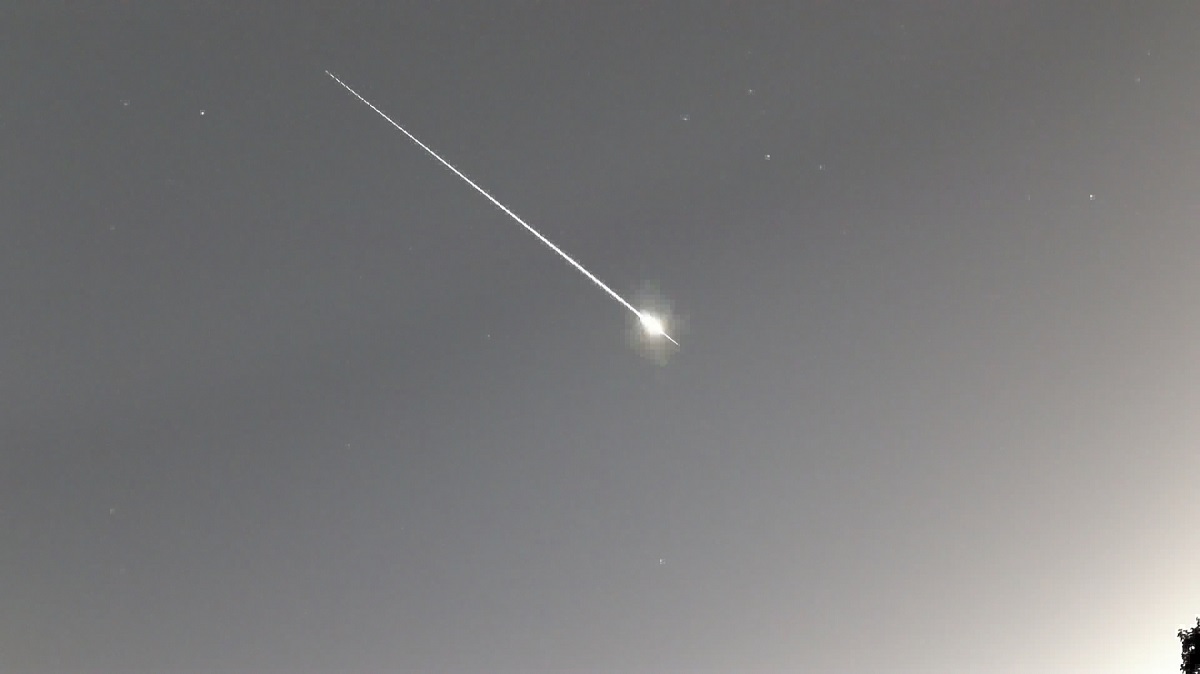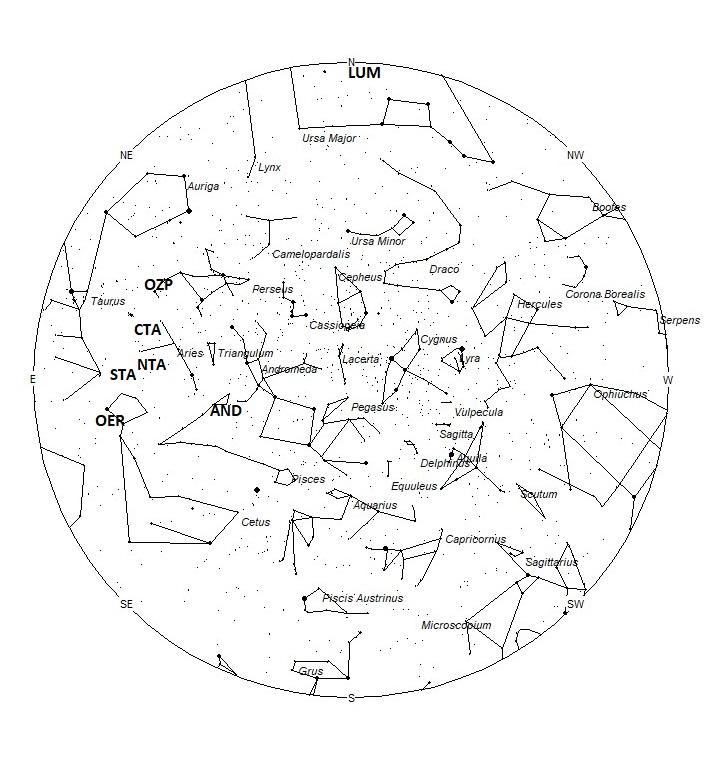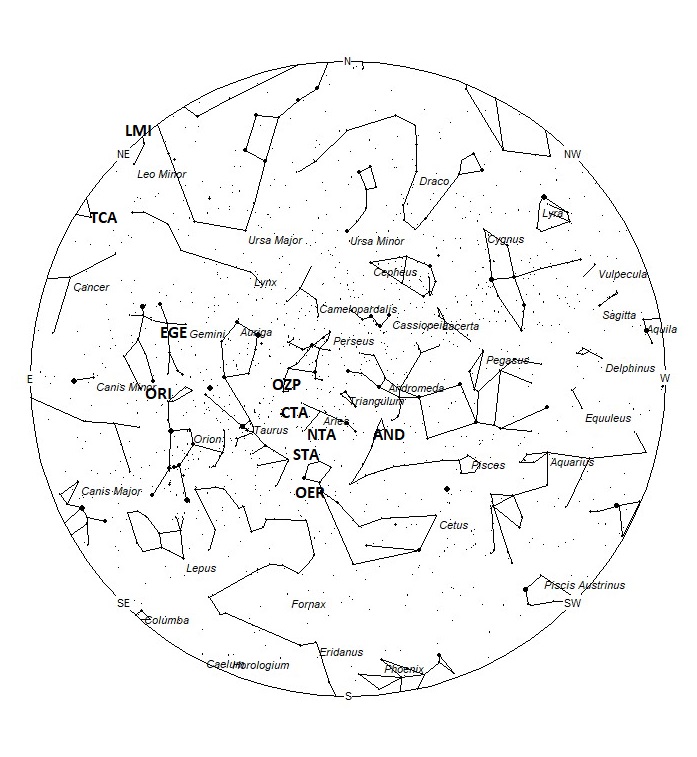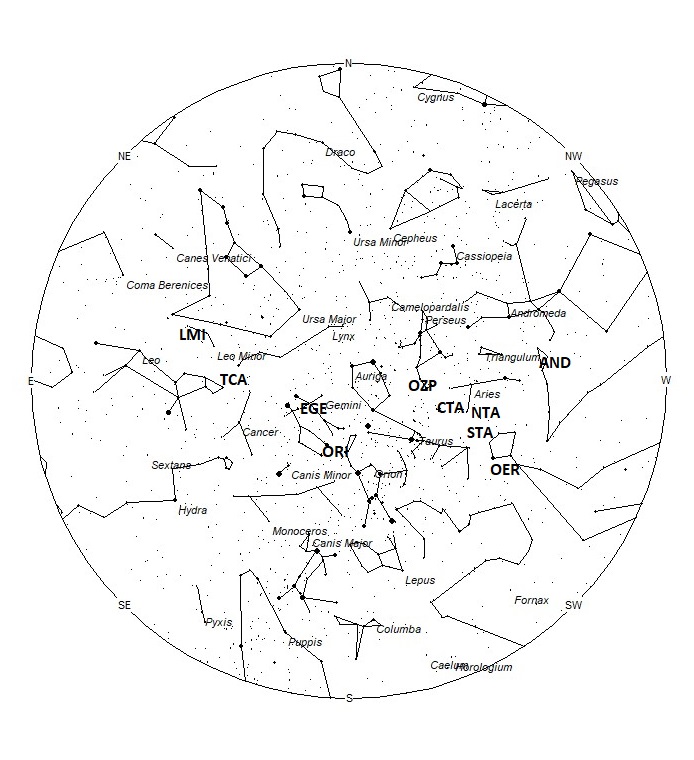 Jordan Ragsdale captured this brilliant fireball with a terminal flare using his AllSky Camera System on July 20, 2022, at 05:30 MDT (11:30 UT) from Eagle, Idaho, USA. ©Jordan Ragsdale
Jordan Ragsdale captured this brilliant fireball with a terminal flare using his AllSky Camera System on July 20, 2022, at 05:30 MDT (11:30 UT) from Eagle, Idaho, USA. ©Jordan RagsdaleDuring this period, the moon reaches its new phase on Tuesday October 25th. At that time the moon will lie near the sun and will be invisible at night. As the week progresses the waxing crescent moon will enter the evening sky but will be so thin and will set so early that it will not interfere with meteor observing. This weekend the moon will rise just prior to dawn and will not interfere with meteor observing. The estimated total hourly rates for evening observers this week should be near 5 as seen from mid-northern latitudes (45N) and 4 as seen from tropical southern locations (25S) For morning observers, the estimated total hourly rates should be near 25 as seen from mid-northern latitudes (45N) and 20 as seen from tropical southern locations (25S). The actual rates will also depend on factors such as personal light and motion perception, local weather conditions, alertness, and experience in watching meteor activity. Note that the hourly rates listed below are estimates as viewed from dark sky sites away from urban light sources. Observers viewing from urban areas will see less activity as only the brighter meteors will be visible from such locations.
The radiant (the area of the sky where meteors appear to shoot from) positions and rates listed below are exact for Saturday night/Sunday morning October 22/23. These positions do not change greatly day to day so the listed coordinates may be used during this entire period. Most star atlases (available at science stores and planetariums) will provide maps with grid lines of the celestial coordinates so that you may find out exactly where these positions are located in the sky. I have also included charts of the sky that display the radiant positions for evening, midnight, and morning. The center of each chart is the sky directly overhead at the appropriate hour. These charts are oriented for facing south but can be used for any direction by rotating the charts to the desired direction. A planisphere or computer planetarium program is also useful in showing the sky at any time of night on any date of the year. Activity from each radiant is best seen when it is positioned highest in the sky, either due north or south along the meridian, depending on your latitude. It must be remembered that meteor activity is rarely seen at the radiant position. Rather they shoot outwards from the radiant, so it is best to center your field of view so that the radiant lies at the edge and not the center. Viewing there will allow you to easily trace the path of each meteor back to the radiant (if it is a shower member) or in another direction if it is sporadic. Meteor activity is not seen from radiants that are located far below the horizon. The positions below are listed in a west to east manner in order of right ascension (celestial longitude). The positions listed first are located further west therefore are accessible earlier in the night while those listed further down the list rise later in the night.
These sources of meteoric activity are expected to be active this week.
.
The Andromedids (AND) are the annual debris encountered from the remains of comet 3D/Biela. These meteors should not be mistaken for the great meteor storms of the 19th century as those meteors are in a slightly different orbit and irregularly encountered in early December. They are known as the December phi Cassiopeiids (DPC). It is interesting that during November, this radiant moves northward toward the area of the DPC’s but ends before reaching the DPC radiant. The radiant currently is located near 01:07 (017) +18. This position lies in eastern Pisces, 5 degrees northwest of the 4th magnitude star known as eta Piscium. This part of the sky is best placed near midnight local Daylight Saving time (LDST), when the radiant lies highest above the horizon. Face toward the north at this time to best see these meteors. With the November 6th maximum still two weeks away, current rates would most likely be less than 1 per hour no matter your location. With an entry velocity of 21 km/sec., the average Andromedid meteor would be of very slow velocity.
The omicron Eridanids (OER) was discovered by the Japanese video meteor network SonotaCo from video data obtained during 2007-2008. These meteors are active from October 23 through December 2nd. Maximum activity is ill-defined and may occur anytime from November 3-27. The date listed in the table represents the midpoint of the activity c14urve and not the actual date of maximum activity. The radiant is currently located at 02:54 (44) +01, which is located in northeastern Cetus, 3 degrees southwest of the 3rd magnitude star known as Menkar (alpha Ceti). This radiant is best placed near 0200 LDST, when it lies on the meridian and is located highest in the sky. Face toward the south at this time to best see these meteors. Rates at this time should be less than 1 per hour no matter your location. With an entry velocity of 31 km/sec., the average OER meteor would be of medium-slow velocity.
The Northern Taurids (NTA) are active from a radiant located at 02:54 (44) +19. This area of the sky is located in central Aries, 3 degrees southwest of the 4th magnitude star known as Botein (delta Arietis). To best see these meteors, one should face southward near 02:00 LDST. Maximum activity is not until November 12th so rates at this time should be near 1 per hour no matter your location. With an entry velocity of 31 km/sec., the average NTA meteor would be of medium-slow velocity.
The Southern Taurids (STA) are very complex and recent investigations have revealed two distinct components of this meteor shower. The first component represents the early and regular annual activity of Southern Taurids, and the latter component represents the main source of activity and is periodic. The early STA’s are active from September 28 through November 7 and peaks on October 17th. The main component of the STA’s is active from October 13 through December 2 and peaks on November 5th*. These two components lie only 5 degrees apart and would be difficult to distinguish by visual means. Therefore, we will list the mean position of these two sources which happens to be 02:58 (45) +13. This position lies in southeastern Aries, 4 degrees north of the 5th magnitude star known as lambda Ceti. Like the NTA’s, to best see these meteors one should face southward near 02:00 LDST. Rates at this time should be near 5 per hour as seen from the Northern Hemisphere and 4 per hour as seen from south of the equator. With an entry velocity of 30 km/sec., the average STA meteor would be of medium-slow velocity.
*The activity of meteor showers recorded by SonotaCo Net video observations 2007–2018, Masahiro Koseki, 2021, https://www.meteornews.net/2021/02/09/february-2021-special-issue-of-emeteornews-online/ Page 170
The chi Taurids (CTA) were discovered by Dr. Peter Brown during his 7-year survey using the Canadian Meteor Orbit Radar (CMOR). This source is active from October 24 through November 13 with a maximum occurring near November 4th. The radiant is currently located at 03:31 (053) +25, which places it on the Taurus/Aries border, 3 degrees west of the naked eye open cluster known as the Pleiades. These meteors may be seen all night long but the radiant is best placed near 0300 LDST when it lies on the meridian and is located highest in the sky. Face toward the south at this time to best see these meteors. Current rates should be less than 1 per hour no matter your location. With an entry velocity of 42 km/sec., the average chi Taurid meteor would be of medium velocity.
The October zeta Perseids (OZP) produced a short-lived outburst last year centered at 21:00 Universal Time on October 24th. The outburst only lasted three hours and was witnessed over Europe. If a repeat performance occurs in 2022, it is expected to peak near 3:00 UT on October 25th. This timing favors North America with the timing ranging from 11pm EDT to 8pm PDT on October 24th. Note that this occurs on the Monday evening October 24th for observers located in North America. The eastern half of North America is favored over the west due to a higher radiant location from that area. The radiant is located at 03:53 (058) +34, which is located in southern Perseus, 3 degrees northwest of the 3rd magnitude star known as zeta Persei. Last year a total of 14 bright meteors were recorded on video cameras operated by the Global Meteor Network*. Undoubtedly there were many more to be seen. If a repeat performance occurs, no matter your location, it would be best to face toward the northeast at the times mentioned above. Other areas in the Northern Hemisphere are encouraged to also try and verify any activity from this source on the nights of October 23-26. At 48km/sec., most of these meteors would possess medium-swift velocities.
*October zeta Perseid meteor shower (OZP #1131), posted by Denis Vida, Global Meteor Network, https://www.meteornews.net/2021/10/28/october-zeta-perseid-meteor-shower-ozp01131/ Accessed 20 October 2022
The Orionids (ORI) are active from September 26 through November 22, with maximum activity occurring on October 21st. The radiant is currently located at 06:27 (097) +16, which places it on the Orion/Gemini border, 3 degrees southwest of the 2nd magnitude star known as Alhena (gamma Geminorum). To best see these meteors, face toward the south during the last hours prior to dawn. Current rates are expected to be near 10 per hour, no matter your location. With an entry velocity of 66 km/sec., the average ORI meteor would be of swift velocity. Also see: https://www.amsmeteors.org/2022/10/viewing-the-orionid-meteor-shower-in-2022/
The epsilon Geminids (EGE) are active from a radiant located at 07:00 (105) +28. This area of the sky lies in northern Gemini, 4 degrees south of the 4th magnitude star known as (tau Geminorum). To best see these meteors, face toward the east during the last dark hour prior to dawn. These meteors are active from September 27 through November 8, with maximum activity occurring on October 19. Hourly rates at this time should be near 1 as seen for the Northern Hemisphere and less than 1 per hour as seen from south of the equator. With an entry velocity of 69 km/sec., the average EGE meteor would be of swift velocity.
The tau Cancrids (TCA) are a weak shower with a long activity period of seven weeks. They are active from September 23 through November 12 with maximum activity occurring on October 20th. The radiant currently lies at 09:20 (140) +30, which places it in northeastern Cancer, 5 degrees south of the 3rd magnitude star known as alpha Lyncis. To best see these meteors, face eastward during the last two hours of the morning prior to dawn. Expected hourly rates are less than 1 per hour no matter your location. With an entry velocity of 67 km/sec., the average TCA meteor would be of swift velocity.
The lambda Ursa Majorids (LUM) were discovered by Željko Andreić and the Croatian Meteor Network team based on studying SonotaCo and CMN observations (SonotaCo 2007-2011, CMN 2007-2010). These meteors are active from October 18 through November 7, with maximum activity occurring on October 28th. The current location of the LUM radiant lies near 10:11 (153) +52. This area of the sky lies in western Ursa Major, 5 degrees east of the 3rd magnitude star known as theta Ursae Majoris. This area of the sky is best placed in the sky during the last hour before dawn, when it lies highest above the horizon in a dark sky. Current rates should be less than 1 per hour no matter your location. Due to the high northern location of this radiant, these meteors are difficult to see from the Southern Hemisphere. With an entry velocity of 61km/sec., most activity from this radiant would be of swift speed.
The Leonis Minorids (LMI) are active from October 13th to November 3rd, with maximum activity occurring on October 21st. The radiant is located at 10:44 (161) +37, which places it in northeastern Leo Minor, 3 degrees east of the 4th magnitude star known as beta Leonis Minoris. These meteors are best seen by facing toward the northeast during the last couple of hours prior to dawn. This shower is better for observers situated in the Northern Hemisphere where the radiant rises far higher into the sky before the start of morning twilight. Current hourly rates would be near 1 as seen from the Northern Hemisphere and less than 1 as seen from south of the equator. At 61km/sec., the average Leonis Minorid is swift. From my personal experience this minor shower produces a high proportion of bright meteors.
Sporadic meteors are those meteors that cannot be associated with any known meteor shower. All meteor showers are evolving and disperse over time to the point where they are no longer recognizable. Away from the peaks of the major annual showers, these sporadic meteors make up the bulk of the activity seen each night. As seen from the mid-Northern Hemisphere (45N) one would expect to see during this period approximately 10 sporadic meteors per hour during the last hour before dawn as seen from rural observing sites. Evening rates would be near 3 per hour. As seen from the tropical Southern latitudes (25S), morning rates would be near 7 per hour as seen from rural observing sites and 2 per hour during the evening hours. Locations between these two extremes would see activity between these listed figures.
You can keep track of the activity of these meteor showers as well as those beyond the limits of visual observing by visiting the NASA Meteor Shower Portal available at: https://meteorshowers.seti.org/ You can move the sky globe to see different areas of the sky. Colored dots indicate shower meteors while white dots indicate sporadic (random) activity. The large orange disk indicates the position of the sun so little activity will be seen in that area of the sky.
The list below offers the information in tabular form of the showers that I feel are within reach of the visual observer to discern. Hourly rates are often less than 1 but noting parameters such as the radiant distance and the elevation, one can compute the probably of shower association. Most showers discovered by video means have rates less than 1 per night away from maximum, so these listed showers are not as weak as they seem. Rates and positions are exact for Saturday night/Sunday morning except where noted in the shower descriptions.
| SHOWER | DATE OF MAXIMUM ACTIVITY | CELESTIAL POSITION | ENTRY VELOCITY | CULMINATION | HOURLY RATE | CLASS |
| RA (RA in Deg.) DEC | Km/Sec | Local Daylight Saving Time | North-South | |||
| Andromedids (AND) | Nov 06 | 01:07 (017) +18 | 21 | 00:00 | <1 – <1 | IV |
| Omicron Eridanids (OER) | Nov 13 | 02:54 (44) +01 | 31 | 02:00 | <1 – <1 | IV |
| Northern Taurids (NTA) | Nov 12 | 02:54 (44) +19 | 31 | 02:00 | <1 – <1 | II |
| Southern Taurids (STA) | Nov 05 | 02:58 (45) +13 | 30 | 02:00 | 5 – 4 | II |
| chi Taurids (CTA) | Nov 04 | 03:31 (053) +25 | 30 | 03:00 | 5 – 4 | II |
| October zeta Perseids (OZP) | Oct 25 | 03:53 (58) +34 | 48 | 03:00 | ? | IV |
| Orionids (ORI) | Oct 21 | 06:27 (097) +16 | 66 | 05:00 | 10 – 10 | I |
| epsilon Geminids (EGE) | Oct 19 | 07:00 (105) +28 | 69 | 06:00 | 1 – <1 | II |
| tau Cancrids (TCA) | Oct 20 | 09:20 (140) +30 | 67 | 08:00 | <1 – <1 | IV |
| lambda Ursa Majorids (LUM) | Oct 28 | 10:11 (153) +52 | 61 | 09:00 | <1 – <1 | IV |
| Leonis Minorids (LMI) | Oct 21 | 10:44 (161) +37 | 61 | 09:00 | 1 – <1 | II |
Class Explanation: A scale to group meteor showers by their intensity:
- Class I: the strongest annual showers with Zenith Hourly Rates normally ten or better.
- Class II: reliable minor showers with ZHR’s normally two to ten.
- Class III: showers that do not provide annual activity. These showers are rarely active yet have the potential to produce a major display on occasion.
- Class IV: weak minor showers with ZHR’s rarely exceeding two. The study of these showers is best left to experienced observers who use plotting and angular velocity estimates to determine shower association. These weak showers are also good targets for video and photographic work. Observers with less experience are urged to limit their shower associations to showers with a rating of I to III.
 American Meteor Society
American Meteor Society



Very interesting write up. I have always been intrigued with space.
Whata lota info!! I stumbled across this,guided by? Ever since I was a little girl I was fascinated by the NIGHT sky. But my biggest question always was What’s all that black stuff? What’s holding everything all together? What if we’re just part of a piece of a smaller world inside of a leg on a chair? Musings of a 5 or 6 year old. It didn’t sit well with most folks and I never got answers until, Dark Matter! And well, way before that more education, entry into the US ARMY, as an air traffic controller. And my continued fascination with the sky and OTHER WORLDLY INTELLIGENCE
On Oct 22nd 2022 in tilbury Ontario Canada at 6am when walking to my tree stand I was looking up at the dark but beautiful morning sky when under neath orions belt I seen what looked like 2 glowing stars? Asteroids? Not sure. One was moving towards another that appeared not to be moving. They made contact and a blue ring outward explosion happened that got as big as a penny if you hold it at arms length while looking at it in the sky. I took a picture of the spot with my phone wondering if anyone else seen or captured it.